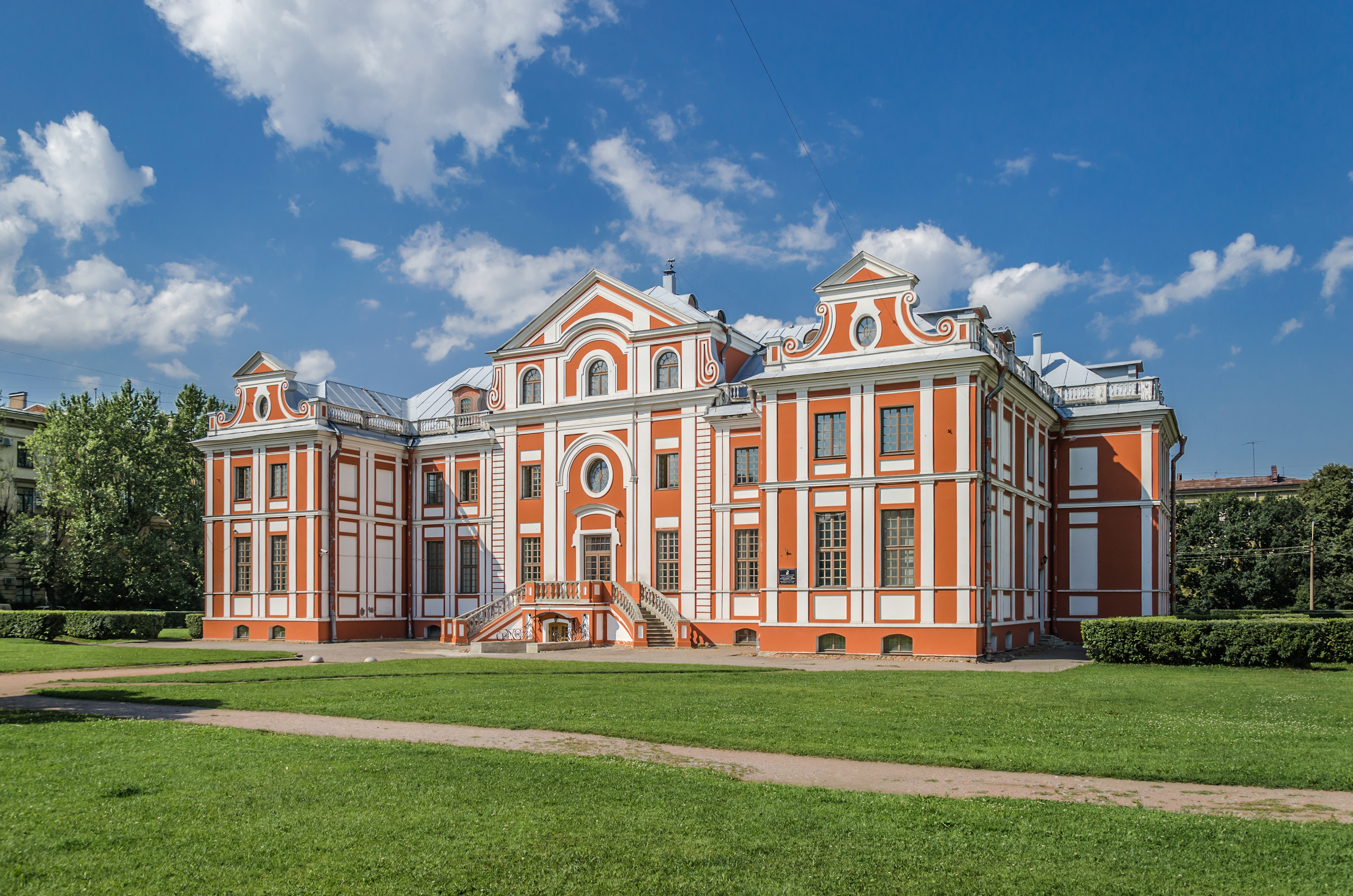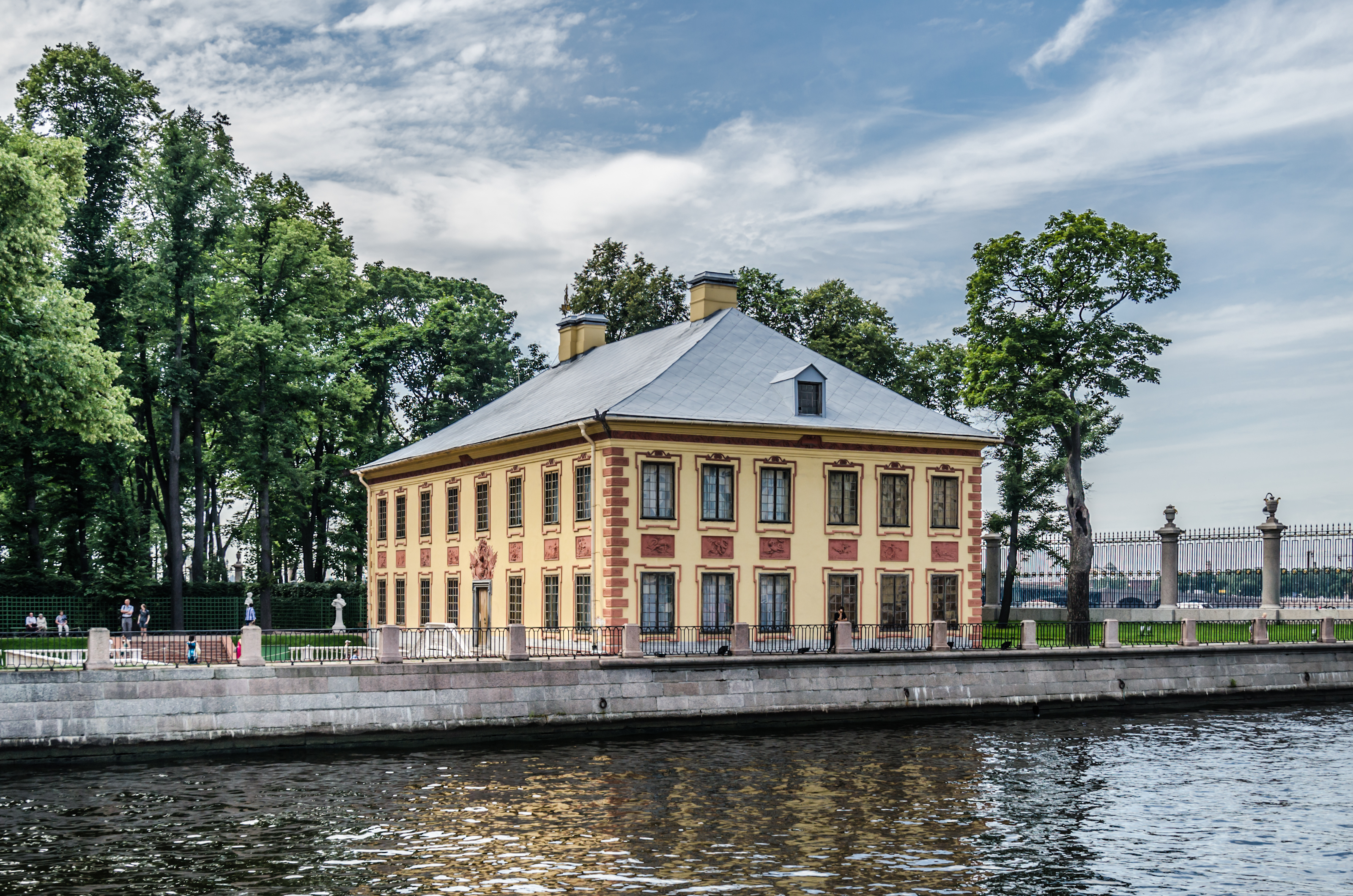|
Petrine Baroque
Petrine Baroque (Russian: Петровское барокко) is a style of 17th and 18th century Baroque architecture and decoration favoured by Peter the Great and employed to design buildings in the newly founded Russian capital, Saint Petersburg, under this monarch and his immediate successors. Different from contemporary Naryshkin Baroque, favoured in Moscow, the Petrine Baroque represented a dramatic departure from Byzantine traditions that had dominated Russian architecture for almost a millennium. Its chief practitioners - Domenico Trezzini, Andreas Schlüter, and Mikhail Zemtsov - drew inspiration from a rather modest Dutch, Danish, and Swedish architecture of the time. Notable examples Extant examples of the style in St Petersburg are the Peter and Paul Cathedral (Trezzini), the Twelve Colleges (Trezzini), the Kunstkamera (Mattarnovi), Kikin Hall (Schlüter) and Menshikov Palace (Giovanni Fontana). The Petrine Baroque structures outside St. Petersburg are scarc ... [...More Info...] [...Related Items...] OR: [Wikipedia] [Google] [Baidu] |
Kadriorg Palace
Kadriorg Palace ( et, Kadrioru loss, german: Schloss Katharinental) is an 18th-century Petrine Baroque palace in Kadriorg, Tallinn, the capital of Estonia. Both the Estonian and the German name for the palace means "Catherine's valley". It was built in 1718–1725 to Nicola Michetti's designs by Gaetano Chiaveri and Mikhail Zemtsov. The palace currently houses the Kadriorg Art Museum, a branch of the Art Museum of Estonia, displaying foreign art from the 16th to 20th centuries. The building of the Kumu branch of the museum, showing Estonian art from the 18th century onwards is located nearby in the Kadriorg Park. Construction After the successful 1710 siege of Reval (Tallinn) during the Great Northern War, Czar Peter the Great of Russia bought a small manor house at Laksberg (Lasnamäe) for his wife Catherine. Plans for a larger palace in the area were developed soon afterwards and construction of a new palace, in what is now Kadriorg, was started on 25 July 1718. The con ... [...More Info...] [...Related Items...] OR: [Wikipedia] [Google] [Baidu] |
Alexander Nevsky Lavra
Saint Alexander Nevsky Lavra or Saint Alexander Nevsky Monastery was founded by Peter I of Russia in 1710 at the eastern end of the Nevsky Prospekt in Saint Petersburg, in the belief that this was the site of the Neva Battle in 1240 when Alexander Nevsky, a prince, defeated the Swedes. But the battle took place about away from that site. "On April 5, 1713, in St. Petersburg, in the presence of Peter I, the wooden Church of the Annunciation was consecrated. This day is considered the official founding date of the Alexander Nevsky Lavra." (April 5, 1713 Gregorian was March 25 Julian, feast of the Annunciation.) "The relics of St. Alexander Nevsky were solemnly transferred from Vladimir to the new capital of Russia September 12, 1724, by decree of Peter the Great." (It was August 30 Julian, or September 10 Gregorian; however, since the Russian Orthodox Church still follows the Julian calendar, the transfer of the relics is celebrated on August 30 Julian, which corresponds to Se ... [...More Info...] [...Related Items...] OR: [Wikipedia] [Google] [Baidu] |
Italian Baroque Architecture
Italian Baroque architecture refers to Baroque architecture in Italy. Central Italy Rome The Baroque architecture period began in the Italian period of the basilica with crossed dome and nave. One of the first Roman structures to break with the Mannerist conventions (as exemplified in the Church of the Gesù) was the church of Church of Saint Susanna, designed by Carlo Maderno in 1596. The dynamic organisation of columns and pilasters, central massing, and the protrusion and condensed central decoration add complexity to the structure. Most Baroque buildings present domes. There is an emerging playfulness with the rules of classic design, still maintaining rigour. The same emphasis on plasticity, continuity and dramatic effects is evident in the work of Pietro da Cortona, illustrated by Santi Luca e Martina (1635) and Santa Maria della Pace (1656). Santa Maria della Pace, with its concave wings devised to simulate a theatrical set, fills a tiny piazza in front of it. Other Roma ... [...More Info...] [...Related Items...] OR: [Wikipedia] [Google] [Baidu] |
French Baroque Architecture
French Baroque architecture, sometimes called French classicism, was a style of architecture during the reigns of Louis XIII (1610–43), Louis XIV (1643–1715) and Louis XV (1715–74). It was preceded by French Renaissance architecture and Mannerism and was followed in the second half of the 18th century by French Neoclassical architecture. The style was originally inspired by the Italian Baroque architecture style, but, particularly under Louis XIV, it gave greater emphasis to regularity, the colossal order of facades, and the use of colonnades and cupolas, to symbolize the power and grandeur of the King. Notable examples of the style include the Grand Trianon of the Palace of Versailles, and the dome of Les Invalides in Paris. In the final years of Louis XIV and the reign of Louis XV, the colossal orders gradually disappeared, the style became lighter and saw the introduction of wrought iron decoration in rocaille designs. The period also saw the introduction of monumental u ... [...More Info...] [...Related Items...] OR: [Wikipedia] [Google] [Baidu] |
Summer Palace Of Peter The Great
The Summer Palace of Peter the Great (russian: link=no, Летний дворец Петра I) was built between 1710 and 1714 in the northeast corner of the Summer Garden, located on an island formed by the Fontanka River, Moyka River, and the Swan Canal. Its northern perimeter runs along the left bank of the Neva River across from the Cabin of Peter the Great and Peter and Paul Fortress and was the first palace built in Saint Petersburg, the second largest city in Russia. It was the first palace built in Saint Petersburg and the city's first building which had piped water. The building is currently a museum. Construction The Summer Palace was planned in 1710 by Peter the Great and built by the Swiss Italian architect Domenico Trezzini, who elaborated on the Petrine Baroque style of Russian architecture with a two-story stone building with four-sloped roofing. Compared with other European palaces of the time the Summer Palace was a very modest building, reminiscent of ... [...More Info...] [...Related Items...] OR: [Wikipedia] [Google] [Baidu] |
James Cracraft
James Cracraft is an historian of Russia who is professor emeritus of history at the University of Illinois. He was a Guggenheim Fellow in 1999. John Simon Guggenheim Memorial Foundation. Retrieved 10 October 2017. Selected publications * ''The Church Reform of Peter the Great''. , 1971. * ''For God and Peter the Great: The Works of Thomas Consett, 1723-1729''. East European Monographs 96/Columbia University Press, 1981. (Editor) * ''The Soviet Union Today: An Interpretive Guide''. |
Naval Architecture
Naval architecture, or naval engineering, is an engineering discipline incorporating elements of mechanical, electrical, electronic, software and safety engineering as applied to the engineering design process, shipbuilding, maintenance, and operation of marine vessels and structures. Naval architecture involves basic and applied research, design, development, design evaluation (classification) and calculations during all stages of the life of a marine vehicle. Preliminary design of the vessel, its detailed design, construction, trials, operation and maintenance, launching and dry-docking are the main activities involved. Ship design calculations are also required for ships being modified (by means of conversion, rebuilding, modernization, or repair). Naval architecture also involves formulation of safety regulations and damage-control rules and the approval and certification of ship designs to meet statutory and non-statutory requirements. Main subjects The word "vessel" in ... [...More Info...] [...Related Items...] OR: [Wikipedia] [Google] [Baidu] |
Dutch Baroque Architecture
Dutch Baroque architecture is a variety of Baroque architecture that flourished in the Dutch Republic and its colonies during the Dutch Golden Age of the 17th century. (Dutch painting during the period is covered by Dutch Golden Age painting). Like contemporary developments in England, Dutch Palladianism is marked by sobriety and restraint. The architecture of the first republic in Northern Europe was meant to reflect democratic values by quoting extensively from classical antiquity. It found its impetus in the designs of Hendrick de Keyser, who was instrumental in establishing a Venetian-influenced style into early 17th-century architecture through new buildings like the Noorderkerk ("Northern church", 1620–1623) and Westerkerk ("Western church", 1620–1631) in Amsterdam. In general, architecture in the Low Countries, both in the Counter-Reformation-influenced south and Protestant-dominated north, remained strongly invested in northern Italian Renaissance and Mannerist forms t ... [...More Info...] [...Related Items...] OR: [Wikipedia] [Google] [Baidu] |
Summer Palace St Petersburg
Summer is the hottest of the four temperate seasons, occurring after spring and before autumn. At or centred on the summer solstice, the earliest sunrise and latest sunset occurs, daylight hours are longest and dark hours are shortest, with day length decreasing as the season progresses after the solstice. The date of the beginning of summer varies according to climate, tradition, and culture. When it is summer in the Northern Hemisphere, it is winter in the Southern Hemisphere, and vice versa. Timing From an astronomical view, the equinoxes and solstices would be the middle of the respective seasons, but sometimes astronomical summer is defined as starting at the solstice, the time of maximal insolation, often identified with the 21st day of June or December. By solar reckoning, summer instead starts on May Day and the summer solstice is Midsummer. A variable seasonal lag means that the meteorological centre of the season, which is based on average temperature patt ... [...More Info...] [...Related Items...] OR: [Wikipedia] [Google] [Baidu] |
Grand Kremlin Palace
The Grand Kremlin Palace (russian: Большой Кремлёвский дворец - ) was built from 1837 to 1849 in Moscow, Russia, on the site of the estate of the Grand Princes, which had been established in the 14th century on Borovitsky Hill. Designed by a team of architects under the management of Konstantin Thon, it was intended to emphasise the greatness of Russian autocracy. Konstantin Thon was also the architect of the Kremlin Armoury and the Cathedral of Christ the Savior. History The Grand Kremlin Palace was formerly the tsar's Moscow residence. Its construction involved the demolition of the previous Baroque architecture, Baroque palace on the site, designed by Francesco_Bartolomeo_Rastrelli, Rastrelli, and the Church of St. John the Baptist, constructed to a design by Aloisio the New in place of the first church ever built in Moscow. Thon's palace is 124 metres long, 47 metres high, and has a total area of about 25,000 square metres. It includes the earlier Te ... [...More Info...] [...Related Items...] OR: [Wikipedia] [Google] [Baidu] |





.jpg)
